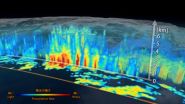(Press-News.org) NASA and the Japan Aerospace Exploration Agency (JAXA) have released the first images captured by their newest Earth-observing satellite, the Global Precipitation Measurement (GPM) Core Observatory, which launched into space Feb. 27.
The images show precipitation falling inside a March 10 cyclone over the northwest Pacific Ocean, approximately 1,000 miles east of Japan. The data were collected by the GPM Core Observatory's two instruments: JAXA's Dual-frequency Precipitation Radar (DPR), which imaged a three-dimensional cross-section of the storm; and, NASA's GPM Microwave Imager (GMI), which observed precipitation across a broad swath.
"It was really exciting to see this high-quality GPM data for the first time," said GPM project scientist Gail Skofronick-Jackson at NASA's Goddard Spaceflight Center in Greenbelt, Md. "I knew we had entered a new era in measuring precipitation from space. We now can measure global precipitation of all types, from light drizzle to heavy downpours to falling snow."
The satellite's capabilities are apparent in the first images of the cyclone. Cyclones such as the one imaged -- an extra-tropical cyclone -- occur when masses of warm air collide with masses of cold air north or south of the tropics. These storm systems can produce rain, snow, ice, high winds, and other severe weather. In these first images, the warm front ahead of the cyclone shows a broad area of precipitation -- in this case, rain -- with a narrower band of precipitation associated with the cold front trailing to the southwest. Snow is seen falling in the northern reaches of the storm.
The GMI instrument has 13 channels that measure natural energy radiated by Earth's surface and also by precipitation itself. Liquid raindrops and ice particles affect the microwave energy differently, so each channel is sensitive to a different precipitation type. With the addition of four new channels, the GPM Core Observatory is the first spacecraft designed to detect light rain and snowfall from space.
In addition to seeing all types of rain, GMI's technological advancements allow the instrument to identify rain structures as small as about 3 to 9 miles (5 to 15 kilometers) across. This higher resolution is a significant improvement over the capability of an earlier instrument flown on the Tropical Rainfall Measurement Mission in 1997.
"You can clearly see them in the GMI data because the resolution is that much better," said Skofronick-Jackson.
The DPR instrument adds another dimension to the observations that puts the data into high relief. The radar sends signals that bounce off the raindrops and snowflakes to reveal the 3D structure of the entire storm. Like GMI, its two frequencies are sensitive to different rain and snow particle sizes. One frequency senses heavy and moderate rain. A new, second radar frequency is sensitive to lighter rainfall and snowfall.
"Both return independent measurements of the size of raindrops or snowflakes and how they are distributed within the weather system," said DPR scientist Bob Meneghini at Goddard. "DPR allows scientists to see at what height different types of rain and snow or a mixture occur -- details that show what is happening inside sometimes complicated storm systems."
The DPR data, combined with data from GMI, also contribute to more accurate rain estimates. Scientists use the data from both instruments to calculate the rain rate, which is how much rain or snow falls to Earth. Rain rate is one of the Core Observatory's essential measurements for understanding where water is on Earth and where it's going.
"All this new information comes together to help us better understand how fresh water moves through Earth's system and contributes to things like floods and droughts," said Skofronick-Jackson.
GMI was built by Ball Aerospace & Technologies, Corp., in Boulder, Colo., under contract to NASA. DPR was developed by JAXA with the National Institute of Information and Communication Technology.
These first GPM Core Observatory images were captured during the first few weeks after launch, when mission controllers at the NASA Goddard Mission Operations Center put the spacecraft and its science instruments through their paces to ensure they were healthy and functioning as expected. The engineering team calibrates the sensors, and Goddard's team at the Precipitation Processing System verifies the accuracy of the data.
INFORMATION:
This initial science data from the GPM Core Observatory will be validated and then released for free by September online at:
http://pps.gsfc.nasa.gov
For more information and the GPM mission, visit:
http://www.nasa.gov/gpm
and
http://www.jaxa.jp/projects/sat/gpm/index_e.html
The GPM Core Observatory was the first of five planned Earth science launches for the agency in 2014. The joint NASA/JAXA mission will study rain and snow around the world, joining with an international network of partner satellites to make global observations every three hours.
NASA monitors Earth's vital signs from land, air and space with a fleet of satellites and ambitious airborne and ground-based observation campaigns. NASA develops new ways to observe and study Earth's interconnected natural systems with long-term data records and computer analysis tools to better see how our planet is changing. The agency shares this unique knowledge with the global community and works with institutions in the United States and around the world that contribute to understanding and protecting our home planet.
For more information about NASA's Earth science activities in 2014, visit:
http://www.nasa.gov/earthrightnow
First images available from NASA-JAXA global rain and snowfall satellite
2014-03-26
ELSE PRESS RELEASES FROM THIS DATE:
The advantages of entering the workforce in a recession
2014-03-26
Despite the well-documented disadvantages of graduating from college during a recession, could graduates actually be happier with their jobs in the long run?
A new article from Administrative Science Quarterly examines whether earning a college or graduate degree in a recession or an economic boom has lasting effects on job satisfaction. Across three studies, well-educated graduates who entered the workforce during economic downturns were happier with their work than those who first searched for jobs during more prosperous times. In fact, they were happier with their ...
Immunotherapy data heralds new era of lung cancer treatment
2014-03-26
Geneva, Switzerland, 26 March 2014 -- A new era of lung cancer therapy is close to dawning, using drugs that can prevent tumour cells from evading the immune system, experts have said at the 4th European Lung Cancer Congress.
For decades, scientists and doctors thought immunotherapy –treatments that harness the immune system to fight a disease-- was of marginal benefit in lung cancer, says Jean-Charles Soria, Institute Gustave Roussy in Paris, France.
However a new class of drugs known as "immunocheckpoint regulators" have shown huge potential, Soria says. New data ...
Planning and building products and production plants simultaneously
2014-03-26
In early 2010, LANXESS decided to enter a new field of business, water purification: A production facility for Lewabrane reverse osmosis membrane filter elements was supposed to be built by the fall of 2011. Together with the company's experts, researchers from the Fraunhofer Institute for Factory Operation and Automation IFF in Magdeburg designed and had the manufacturing technology ready for production in just nine months. Afterward, they built a second, fully automatic and, therefore, more complex plant in just one year. Part of this plant – scaled down – will be on ...
Harvard scientists visualize new treatments for retinal blindness
2014-03-26
A new report published online in The FASEB Journal may lead the way toward new treatments or a cure for a common cause of blindness (proliferative retinopathies). Specifically, scientists have discovered that the body's innate immune system does more than help ward off external pathogens. It also helps remove sight-robbing abnormal blood vessels, while leaving healthy cells and tissue intact. This discovery is significant as the retina is part of the central nervous system and its cells cannot be replaced once lost. Identifying ways to leverage the innate immune system ...
Genetics can explain why infections can trigger rheumatoid arthritis
2014-03-26
A new international study has revealed how genetics could explain why different environmental exposures can trigger the onset of different forms of rheumatoid arthritis.
A team at the Arthritis Research UK Centre for Genetics and Genomics at The University of Manchester, part of a large international consortium involving scientists from across 15 academic institutions, believe their findings could have important implication for the way that rheumatoid arthritis is diagnosed and treated.
Publishing their findings in the journal American Journal of Human Genetics, they ...
New septic shock biomarker test could boost better interventions
2014-03-26
CINCINNATI – Septic shock is a severe systemic infection and major cause of death for the old and young alike. Unfortunately, researchers say testing new drug regimens to stop the infection is confounded because clinical trials include patients who are either too sick to be saved by experimental therapies or not sick enough to warrant the treatments.
In a study published in the April edition of Critical Care Medicine, researchers at Cincinnati Children's Hospital Medical Center and the University of Cincinnati report a new blood test that helps solve the dilemma by identifying ...
Eat a peach
2014-03-26
PULLMAN, Wash. - A Washington State University food scientist and colleagues at Texas A&M have found that compounds in peaches can inhibit the growth of breast cancer cells and their ability to spread.
Writing in the Journal of Nutritional Biochemistry, the researchers say the compounds could be a novel addition to therapies that reduce the risk of metastasis, the primary killer in breast and many other cancers. The compounds could be given as an extract or, judging from the doses given mice in the study, two to three peaches a day.
"I would do three peaches a day," said ...
The altruistic side of aggressive greed
2014-03-26
KNOXVILLE – In many group-living species, high-rank individuals bully their group-mates to get what they want, but their contribution is key to success in conflict with other groups, according to a study that sheds new light on the evolutionary roots of cooperation and group conflict.
In a series of mathematical models, researchers from the National Institute for Mathematical and Biological Synthesis and the University of Oxford uncovered a mechanism for explaining how between-group conflict influences within-group cooperation and how genes for this behavior might be ...
Recent California symposium highlights women injured in the workplace
2014-03-26
Recent California symposium highlights women injured in the workplace
Article provided by Sacks & Zolonz, LLP
Visit us at http://www.sackszolonzdefense.com
In February the California Applicants' Attorneys Association held a symposium regarding workplace injuries that affect women. "Working Women's Injuries Symposium: Causes, Consequences and Prevention" examined the causes of injuries to women in the workplace and attempted to generate policies that would reduce and better address women's safety while at work.
At the symposium, experts and safety advocates ...
NJ congressman supports federal LGBT employment discrimination ban
2014-03-26
NJ congressman supports federal LGBT employment discrimination ban
Article provided by Piro, Zinna, Cifelli, Paris & Genitempo, L.L.C.
Visit us at http://www.pirozinnalaw.com
Longtime New Jersey Rep. Frank Pallone, Jr., D-N.J., sent a March 18, 2014, letteralong with 220 other members of Congress to President Barack Obama urging him to issue an executive order banning federal contractors from discriminating in employment on the basis of sexual orientation or sexual identity.
ENDA
newjerseynewsroom.com quotes Pallone as also hoping the U.S. House of Representatives ...



